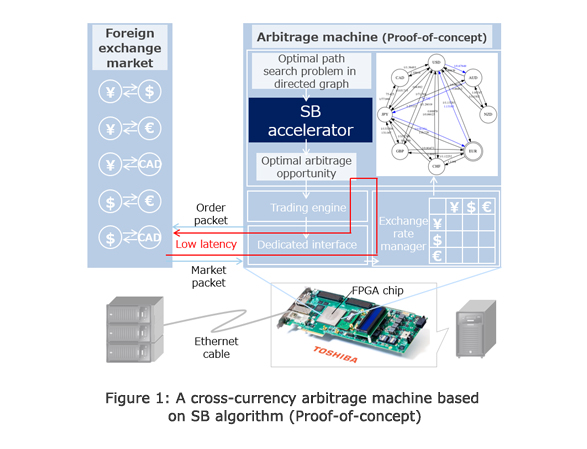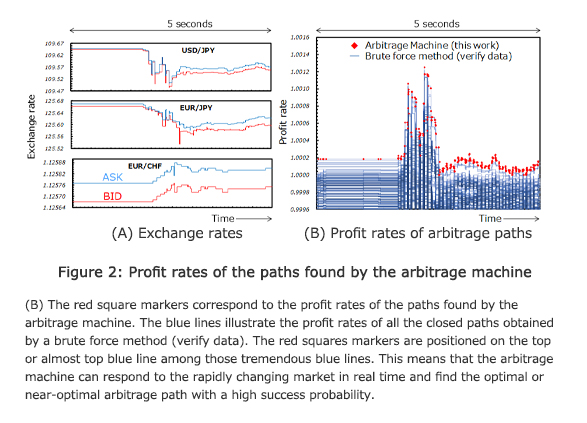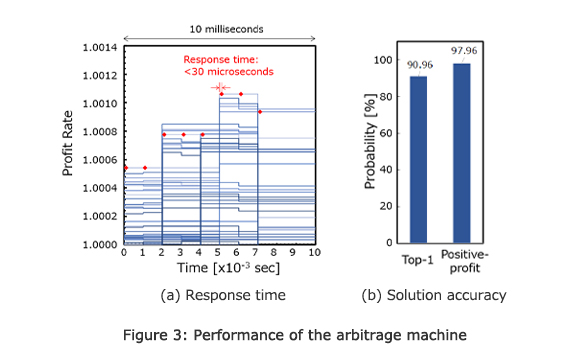Toshiba Develops Proof-of-concept Device for Ultra-high-speed
Financial Transaction Machine with Simulated Bifurcation Algorithm
-Detects most profitable transaction opportunities with
probabilities exceeding 90% at microsecond speeds;
starting open recruitment of financial engineering
experts toward practical applications-
Toshiba Corporation
TOKYO─Toshiba Corporation (TOKYO: 6502)has developed a proof-of-concept (PoC) device for ultra-high-speed financial transaction machines that is the first in the world able to instantly detect and execute optimal arbitrage opportunities from among a huge number of currency combination patterns.
The device is equipped with Toshiba's proprietary simulated bifurcation (SB) algorithm, which obtains high-quality approximate solutions (good solutions) for large-scale, complex combinatorial optimization problems in a short time. In constantly shifting foreign exchange markets, the PoC can detect the most profitable arbitrage opportunities from among a huge number of currency combination patterns, at probabilities exceeding 90%, and issue trade orders in microseconds. This is the world's first demonstration of a device that instantly detects and executes optimal arbitrage. To promote R&D and new business development in the fintech field, Toshiba is hiring financial engineering experts(Note 1).
Toshiba announced development of its SB algorithm on April 20, and development of a processing circuit dedicated to executing that algorithm on September 11. The SB algorithm and its dedicated processing circuit together realize a new system concept, an instantaneous optimal response system. The PoC device demonstrates this new concept by applying it to foreign exchange arbitrage (Figure 1). The technology is expected to foster innovation in finance, industrial robotics, disaster emergency response systems, and other fields requiring high-speed, real-time response.
Toshiba and Toshiba Digital Solutions Corporation will present the device at the Exhibition on Financial Information Technology 2019(Note 2) (Tokyo, October 24─25) and at the Toshiba Open Innovation Fair 2019(Note 3) (Tokyo, November 7─8).
Combinatorial optimization can solve optimization problems related to innovating social and industrial systems, such as financial transactions, operation of industrial robots, and routing for logistics or power transmission, by selecting the best combination patterns among an enormous number of candidates. Solving combinatorial optimization problems at high speed with existing computers is very difficult, because the number of candidate combination patterns exponentially increases with the problem size. Toshiba addressed this issue by developing its proprietary quantum computer, the quantum bifurcation machine (QBM)(Note 4). The company also developed the SB algorithm(Note 5,6,7,8) by extending that quantum machine's theoretical basis to classical dynamics, and realized the world's fastest and largest-scale optimizations. Toshiba also proposed the concept of an instantaneous optimal response system, and announced development of processing circuitry(Note 9,10) dedicated to executing the SB algorithm that will be necessary for realization of that system.
High-speed, real-time response systems, such as those used for financial transactions or in industrial robots, must reduce total response time, including the time taken to search the external environment and to determine and execute an appropriate action. Conventional high-speed systems determine the action to take according to simple condition judgment expressions based on past experience. A system that can achieves both a real-time response and high-speed combinatorial optimization to instantly make the most reasonable judgment according to environmental changes is a new concept, one that has not yet been realized, and its implementation in society will require demonstration experiments.
Toshiba has focused on financial transactions as an activity that requires a high-speed, real-time response, and developed a PoC device that executes arbitrage transactions between multiple currencies(Note 11) in the foreign exchange market.
This device is an ultra-low-latency, all-hardware solution that implements an arbitrage trading system on a single field-programmable gate array (FPGA)(Note 12) (Figure 1). The system consists of a dedicated SB accelerator, a dedicated interface circuit, an exchange rate matrix manager, and a trading engine. It follows an academic formulation of cross-currency arbitrage(Note 11). The dedicated SB accelerator installed in this device instantly finds the most-profitable arbitrage opportunity by solving an optimal path problem in a weighted directed graph(Note 13).
The demonstration used historical tick-by-tick foreign exchange (FX) data(Note 14) in millisecond detail involving fifteen pairs of eight currencies (a directed graph with eight nodes and thirty edges). The PoC device captured market packets for currency pairs that are issued at unscheduled, extremely short time intervals (about one millisecond), and found the optimal arbitrage opportunities (a chain of currency conversions) from among a huge number of possible transaction paths (Figure 2). Order packets determined from that information and the trading algorithm were issued within 30 microseconds of the arrival of the market packet (Figure 3A). This response time is much shorter than that of exchange fluctuation timing (about one millisecond). Furthermore, the likelihood of finding the most profitable arbitrage opportunity among all possible transactions was 90.96%(Note 14). In cases where at least one arbitrage opportunity with positive profitability (profit rate exceeding 1.0) exists, the probability of detecting one of the profitable opportunities reaches 97.96% (Figure 3B)(Note 14). The device thus provides a high-speed response that can instantly respond to rapidly changing market conditions and detect opportunities for maximally profitable margin trading at extremely high probabilities.
Systems that instantly execute most-rational actions in response to a changing environment are expected to find application in a wide range of fields and to foster innovation. For example, they can be applied to financial fields such as high-speed trading of financial assets, dynamic risk assessment, and optimization of transaction costs. Industrial robots will be able to make real-time selections of the most efficient movements, according to surrounding conditions. Such systems will also realize high-speed power transactions that promote use of renewable energy sources whose power generation levels change from moment-by-moment, and dynamic control of power distribution networks to minimize damage from disasters.
Toshiba will advance research and development of financial solutions centered on solving combinatorial optimization problems at high speed with low latency, and in collaboration with Toshiba Digital Solutions Corporation will advance new business development in the fintech field. Toshiba is also recruiting expert human resources to promote R&D and new business development in the field of financial engineering. Toshiba will continue to research and develop innovative instantaneous optimal response systems in fields other than finance.
(postscript added on Oct. 8, 2020)
Toshiba presented the technology at the IEEE International Symposium on Circuits and Systems (ISCAS)(Note 15)(Note 16).



- (Note 1)
- Recruitment of financial engineering experts at Toshiba (at BizReach, Inc.), https://www.bizreach.jp/content/762
- (Note 2)
- Exhibition on Financial Information Technology 2019, https://fit-tokyo.nikkin.co.jp (The Japan Financial News Co.,Ltd.) [Toshiba Digital Solutions, booth T02, session G402-09]
- (Note 3)
- Toshiba Open Innovation Fair 2019,https://www.toshiba-sol.co.jp/event/2019fair/report.htm (Toshiba Digital Solutions Corporation) [booth: Advanced Technologies Corner; session: 2B1W]
- (Note 4)
- H. Goto, "Bifurcation-based adiabatic quantum computation with a nonlinear oscillator network," Scientific Reports 6, 21686 (2016).
- (Note 5)
- Toshiba's Breakthrough Algorithm Realizes World's Fastest, Largest-scale Combinatorial Optimization
-Advance towards building service platform for rapid problem solving in logistics, drug development and other socially important areas- https://www.global.toshiba/ww/technology/corporate/rdc/rd/topics/19/1904_01.html - (Note 6)
- A new solution for combinatorial optimization born from quantum computer research, https://www.toshiba-clip.com/detail/7685
- (Note 7)
- H. Goto, K. Tatsumura, A. R. Dixon, "Combinatorial optimization by simulating adiabatic bifurcations in nonlinear Hamiltonian systems," Sci. Adv. 5, eaav2372 (2019). https://advances.sciencemag.org/content/5/4/eaav2372 (American Association for the Advancement of Science)
- (Note 8)
- Toshiba Digital Solutions Corporation's Simulated Bifurcation Machine, Software Enabling Massive Combinatorial Optimization at High Speed, Now Available on AWS Marketplace: ─ Company starting a demonstration experiment towards solving problems in diverse fields ─ https://www.toshiba-sol.co.jp/en/news/detail/20190717.htm
- (Note 9)
- Toshiba Develops a Dedicated Massively Parallel Processing Circuit for Simulated Bifurcation Algorithms
-Provides real time combinatorial optimization solutions in rapidly changing environments and solves problems related to finance, robotics, logistics, and drug development-, https://www.global.toshiba/ww/technology/corporate/rdc/rd/topics/19/1909_03.html - (Note 10)
- K. Tatsumura, A. R. Dixon, H. Goto, "FPGA-based Simulated Bifurcation Machine," In proceedings of The International Conference on Field-Programmable Logic and Applications (FPL), pp.59-66 (2019) https://ieeexplore.ieee.org/document/8892209 (IEEE)
- (Note 11)
- W. Soon, and H. Q. Ye. "Currency arbitrage detection using a binary integer programming model." International Journal of Mathematical Education in Science and Technology 42, pp. 369-376 (2011).
- (Note 12)
- Field-programmable gate array: A type of arithmetic processing integrated circuit that allows users to rewrite functions after manufacturing according to the application. When using an Intel Arria10 GX1150 FPGA fabricated by 20-nm-generation semiconductor processes.
- (Note 13)
- Detection of currency arbitrage opportunity can be formulated as optimal path search in a directed graph, where the nodes are the assets (currencies) and the edge weights corresponds to the exchange rate. We seek to find a cyclic path that gives the maximum profit rate, where the profit rate is the product of the exchange rates involved in the cycle.
- (Note 14)
- Data source: Integral Development Corp. https://www.truefx.com/ [Under the permission from Integral Dev. Corp.] Using data on January 2019. Detection probability are values averaged over the one month period.
- (Note 15)
- K. Tatsumura, R. Hidaka, M. Yamasaki, Y. Sakai and H. Goto, "A Currency Arbitrage Machine Based on the Simulated Bifurcation Algorithm for Ultrafast Detection of Optimal Opportunity," IEEE International Symposium on Circuits and Systems (ISCAS), pp. 1-5 (2020). https://ieeexplore.ieee.org/document/9181114
- (Note 16)
- M. Yamasaki, R. Hidaka, Y. Sakai, J. Yamaguchi, Y. Nakamura, H. Goto, and K. Tatsumura, "Live Demonstration: Capturing Short-Lived Currency Arbitrage Opportunities with a Simulated Bifurcation Algorithm-Based Trading System," IEEE International Symposium on Circuits and Systems (ISCAS), pp. 1-1 (2020). https://ieeexplore.ieee.org/document/9180679


